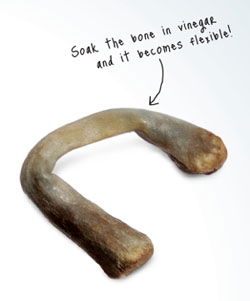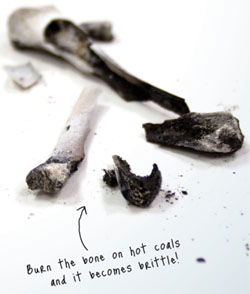What Makes Bones Strong?
Have you ever wondered what makes bones so strong? You may have been told to drink milk, since calcium, a mineral found in milk, is important to strong bones. The body uses calcium to form hydroxylapatite, which it then uses to make bones and teeth hard. But bones need more than hydroxylapatite to make them strong.
Much of the strength of bone stems from the fact that bone is what engineers refer to as a composite material. Composite materials are made up of two components, a matrix and reinforcement, that work together to produce enhanced strength. An ancient example is brick made of clay and straw. Modern examples include reinforced concrete and fiberglass.
Bone has the right mix of two very different components: a very hard inorganic material called hydroxylapatite and a tough, fibrous organic material called collagen (the protein of leather). The crystal material makes up about 70% of the dry weight of bone, while collagen makes up most of the remaining 30%.
If bones were made up entirely of hydroxylapatite, they would shatter under a load. If they were made entirely of collagen, they would be rubbery. Instead, they have a perfect balance of both.1
The wonderful design of bones could not have come about by evolution, requiring millions of years and chance. The Bible says that God made Adam (the first man) out of the dust of the ground on Day Six of the Creation Week, around 6,000 years ago (Genesis 2:7). God designed bones in an amazing way—perfect to withstand the everyday stresses put on our bodies.
Perform this fun experiment to learn more about the balance of collagen and hydroxylapatite in our bones, and why that balance is so important.2 You will need an adult’s help for this experiment.

See For Yourself . . .
The Rubber Bone Experiment
What do you think our bones would be like without any mineral? You can see for yourself by doing an easy (even tasty!) experiment. First, you must eat all the meat off a chicken drumstick, which is actually the tibia and fibula of the chicken’s leg. Then put the chicken tibia (the larger bone) in a small jar filled with enough vinegar to completely cover the bone. Cover the jar and let it sit for two weeks.
When you remove the bone from the vinegar after two weeks, you will find that it has become so flexible you will be able to tie it into a knot! What happened? Vinegar contains an acid (acetic acid) that completely dissolves any mineral in the bone, leaving the flexible organic material, which is 95% collagen. You have essentially produced a leather bone. Imagine what it would be like if all the bones in your body were like this, and then thank God for the mineral in your bones.

The Brittle Bone Experiment
Now you might wonder what bones would be like if you could remove all the organic (carbon-containing) collagen and leave only the mineral. For this you will need another chicken leg (tibia) and the supervision of an adult. Have an adult fire up a charcoal grill until the coals are glowing, and then place the bone directly on the coals. Allow the bone to turn into ash in the fire. This will burn up the organic material, leaving only the mineral.
When this bone is removed from the coals (by an adult) and allowed to cool, it will be so brittle that it is easily broken by tapping it on a hard surface. If our bones were like this, one fall could break nearly every bone in our body.
We can only marvel at the handiwork of God, who created such an engineering masterpiece as our bones.
[Editor’s Note: Adapted from an article by David Menton, “Rubber Chicken Leg,” Answers, October–December 2010, 41–42.]
Footnotes
- David Menton, “Bones—God’s Living Girders,” Answers, October–December 2009, 64–68, https://answersingenesis.org/human-body/bones/.
- David Menton, “Rubber Chicken Leg,” Answers, October–December 2010, 41–42, https://answersingenesis.org/chemistry/rubber-chicken-leg/.
Recommended Resources
- © 2025 Answers in Genesis
- Privacy Policy
- Contact
- About

